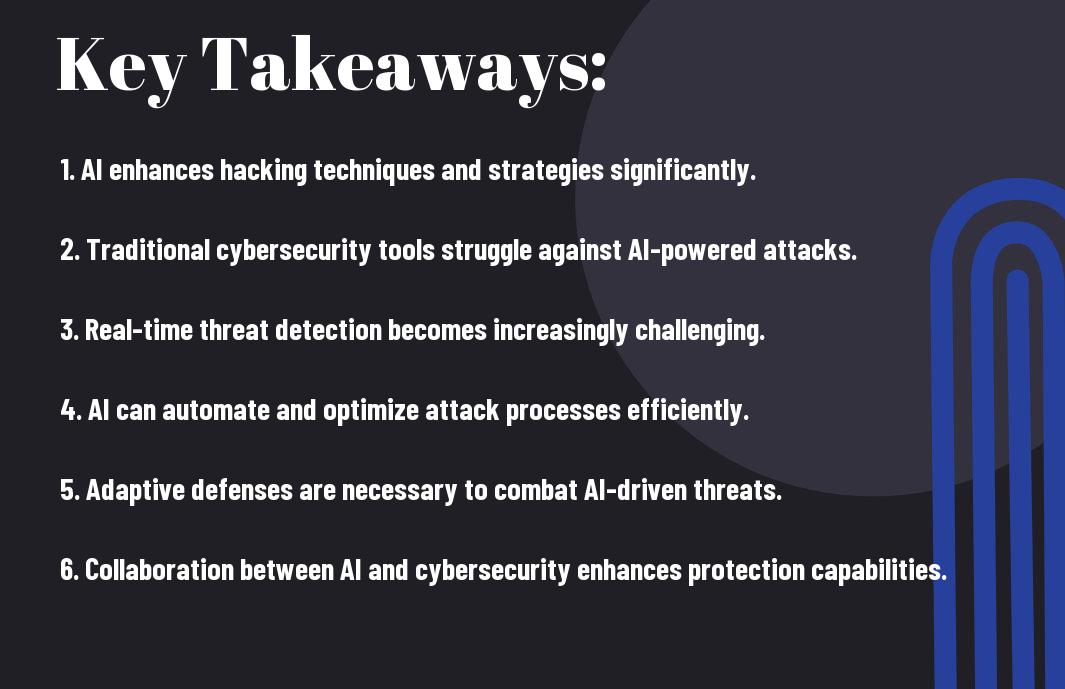AI technologies are rapidly evolving, creating new opportunities and challenges in cybersecurity. You may wonder whether AI-based hackers can outsmart traditional security measures that have served as the first line of defense for years. In this post, we will explore the capabilities of AI in cyber-attacks and how these advancements could potentially undermine the effectiveness of conventional cybersecurity practices. Understanding these dynamics can help you better prepare your defenses against emerging threats.


Understanding AI in Cybersecurity
Before delving into the implications of AI on cybersecurity, it’s vital to understand what AI entails within this field. Artificial Intelligence integrates advanced algorithms and machine learning to enhance security measures, analyze threats, and predict vulnerabilities. Its capacity to process vast amounts of data quickly allows organizations to adapt and respond effectively to evolving cyber threats, thereby improving overall security outcomes.
Definition of AI-Based Attack Techniques
Around cybersecurity, AI-based attack techniques leverage intelligent algorithms to launch sophisticated attacks. These can include automating phishing campaigns, exploiting vulnerabilities in software, and manipulating data patterns to avoid detection. By utilizing AI, hackers can significantly enhance the efficiency of their operations, making them harder to detect and mitigate.
Comparison with Traditional Cyber Threats
Against the backdrop of traditional cyber threats, AI-based attacks offer a contrasting level of complexity and adaptability. Traditional threats often rely on well-known exploits and predictable patterns, whereas AI-driven attacks can evolve over time, analyzing system defenses and adjusting their methods accordingly. Below is a comparison to highlight these differences:
| Aspect | Traditional Threats |
|---|---|
| Adaptability | Limited |
| Complexity | Simple |
| Detection | Easier |
| Automation | Minimal |
Hence, AI-based cyber threats not only present a more sophisticated challenge but also require advanced techniques for detection and response. While traditional security measures may still hold value, they often struggle to keep pace with the rapid evolution and unpredictability of AI threats. Understanding this dichotomy is vital for effectively safeguarding your systems against potential risks associated with AI-driven attacks. Below is further insight into the differences:
| Feature | AI-Based Attacks |
|---|---|
| Learning Ability | Yes, improves over time |
| Resource Intensity | Higher, due to automation |
| Targeting | More precise |
| Nature of Attacks | Adaptive and personalized |
The Evolution of Cybersecurity Methodologies
It is vital to understand that cybersecurity has undergone significant transformations over the years. Historically rooted in basic techniques, it has evolved with advancements in technology and the increasing sophistication of cyber threats. Today, you find yourself in an environment rapidly adapting to new challenges, necessitating a reevaluation of traditional practices and the adoption of innovative strategies to safeguard your digital assets.
Historical Overview of Cyber Defense
By exploring the early initiatives in cyber defense, you can see how organizations began employing basic security measures, like firewalls and antivirus software, in response to straightforward threats. As cyber activities expanded and evolved into more complex attacks, these foundational techniques became insufficient, prompting a shift towards more nuanced and comprehensive security protocols.
Adapting to New Threat Landscapes
After realizing the limitations of traditional defenses, you must embrace the need for continual adaptation to ever-evolving cyber threats. The landscape today is marked by advanced persistence threats, ransomware, and sophisticated phishing schemes, all of which require agile and responsive security measures.
Cybersecurity must involve a proactive approach where you regularly assess new vulnerabilities and invest in emerging technologies. Utilizing threat intelligence, implementing machine learning, and fostering a culture of awareness within your organization are necessary steps. By staying ahead of trends and enhancing your security posture continuously, you can effectively mitigate risks posed by an unpredictable digital environment.
The Role of Machine Learning in Cyber Attacks
Unlike traditional cybersecurity measures, machine learning (ML) empowers cyber attackers to refine their tactics swiftly and effectively. By analyzing vast amounts of data, these attackers can identify vulnerabilities and deploy strategies that traditional methods may overlook. As highlighted in What Is AI in Cybersecurity?, this evolution is setting new standards for risk in the digital landscape.
Automated Exploitation Strategies
At the forefront of ML in cyberattacks are automated exploitation strategies. These systems can generate multiple attack vectors, targeting numerous systems simultaneously with alarming speed and precision. This capability drastically increases the potential for successful breaches.
Enhanced Evasion Techniques
Attacks are becoming increasingly sophisticated, employing enhanced evasion techniques that challenge traditional detection systems. By leveraging ML algorithms, attackers can morph their tactics to avoid signature-based detection, rendering conventional defenses less effective.
Due to the adaptive nature of these enhanced evasion techniques, you may find that new attack methods can dynamically alter their approach based on real-time feedback from security systems. This means attackers can manipulate variables such as packet timing and payload characteristics to bypass firewalls and intrusion detection systems, making it crucial for you to stay vigilant and update your security protocols frequently.
Potential Advantages of AI-Based Hackers
Now, as cybersecurity threats become increasingly sophisticated, AI-based hackers present a new frontier in cyber warfare. You’ll find that these advanced technologies can outmaneuver traditional security defenses, leading to a shift in how attacks are executed. Their ability to learn and adapt offers new opportunities for exploitation that you may need to consider carefully when assessing your cybersecurity posture.
Speed and Efficiency
Across various scenarios, AI-based hackers can execute attacks at a pace that human counterparts simply cannot match. This unprecedented speed allows them to exploit vulnerabilities before security measures have a chance to respond effectively. Consequently, you have to stay vigilant and ensure that your security systems can keep up with these rapid advancements.
Real-time Threat Adaptation
With AI technologies, the ability to adapt to emerging threats in real-time sets these hackers apart. As they collect data about your system’s defenses, they quickly modify their strategies to bypass those safeguards. This adaptability means you must continuously evolve your own tools and methodologies to counter these ever-changing tactics.
AIBased systems can monitor network behavior, attack patterns, and potential vulnerabilities, allowing for immediate adjustments in tactics. By harnessing vast amounts of data, they learn from each encounter, refining their approaches to maximize efficiency. For you, this means the need for an equally agile cybersecurity strategy to anticipate potential breaches and mitigate damage before it’s too late.
Challenges for Traditional Cybersecurity
Many organizations still rely on conventional cybersecurity methods, which are increasingly unable to cope with sophisticated threats. The digital landscape evolves rapidly, and with each advancement in technology, the tactics employed by cybercriminals become more complex. Consequently, traditional defense mechanisms struggle to provide the agility and adaptability required to protect your sensitive data from the modern threat landscape.
Limitations of Current Defense Mechanisms
At present, many of the defense mechanisms you utilize may lack the necessary automation and intelligence to respond effectively to threats. They often depend on predefined rules and signatures, making them unsuitable for detecting new variables or unknown attack vectors. This rigidity can create vulnerabilities that cybercriminals exploit, putting your entire network at risk.
The Growing Complexity of Cyber Attacks
Mechanisms of attack have advanced significantly, making it increasingly difficult for traditional cybersecurity to keep up. Threat actors now employ intricate strategies such as multi-vector attacks, which can simultaneously target different aspects of your infrastructure. This complexity requires not only the detection of threats across various surfaces but also the ability to respond in real-time to quickly neutralize potential breaches.
In fact, the increasingly sophisticated nature of cyber attacks means that they often involve layers of obfuscation and exploitation of multiple vulnerabilities. Attackers utilize AI and machine learning to create adaptive strategies, making it challenging for traditional defenses to detect and mitigate these threats. As you navigate this landscape, it becomes clear that conventional cybersecurity measures are no longer sufficient in defending against an evolving array of cyber threats. You must consider innovative solutions that can keep pace with these sophisticated adversaries.
Future Directions in Cybersecurity
For the evolving landscape of cybersecurity, you must acknowledge the pressing need for adaptive strategies. As AI technologies advance, you should consider how these innovations could outpace traditional defensive measures. Explore Why Traditional Cybersecurity Solutions Can’t Keep Up …, as they may ultimately become less effective against sophisticated AI-driven attacks.
Integration of AI in Security Measures
Below the surface, integrating AI in your security measures can enhance threat detection and response. By leveraging machine learning algorithms, you can analyze vast amounts of data in real-time, allowing for quicker identification of potential threats. Implementing AI-driven security solutions will enable you to stay one step ahead of emerging risks.
Building Resilience Against AI-Driven Threats
Any organization must focus on building resilience to withstand AI-driven threats. Developing a robust incident response plan coupled with continuous training for your team can fortify your defenses. Additionally, regularly updating your security protocols will help create a more agile and adaptive system.
In fact, addressing the risks posed by AI-driven threats requires a multifaceted approach. You should prioritize collaboration between your teams and invest in advanced security technologies that can anticipate and mitigate potential attacks. By fostering a culture of awareness, promoting vigilance among employees, and utilizing predictive analytics, you enhance your organization’s resilience to evolving cyber threats.
Final Words
Following this discussion, you should recognize that AI-based hackers are evolving rapidly, posing unique challenges to traditional cybersecurity methodologies. While the integration of AI can enhance threat detection and response times, it can also empower malicious actors with sophisticated tools. Your understanding of these developments will guide you in implementing proactive strategies to safeguard your systems. Staying informed and adapting your security measures effectively will be crucial in counteracting the potential threats posed by AI-driven cyber attacks.